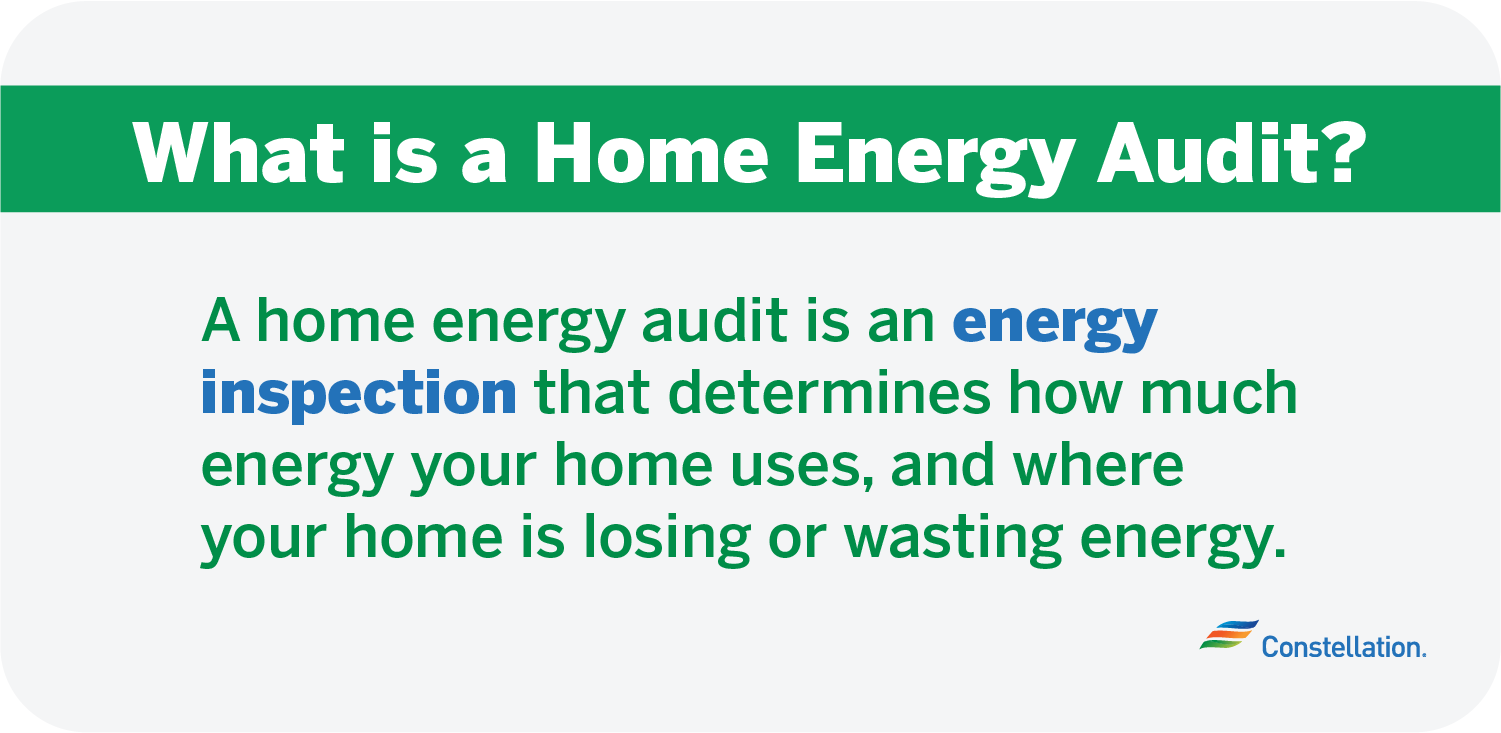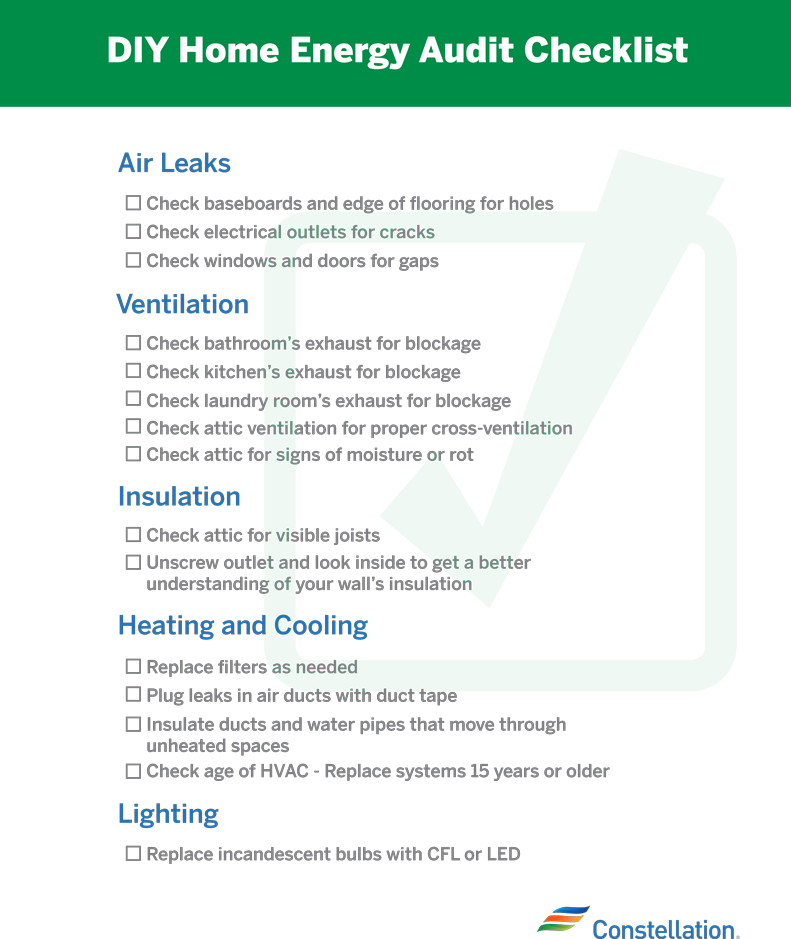
- Category:
Energy Efficiency -
Last updated:
April 3, 2025
What is a Home Energy Audit and How to Do One
The US Energy Information Administration estimates the average annual electricity consumption of a US home is 10,399 kilowatt hours (kWh), and depending on where you live or how you receive energy, a year’s worth of energy can really add up.
But what many homeowners don’t know is that their home could be working against them by wasting energy. Features like doors, windows, or even cracks in the walls can artificially inflate a homeowner’s energy use.
Fortunately, there’s hope. By performing a home energy audit, you can reduce your annual energy costs by identifying energy-saving opportunities. But what is a home energy audit, and how can you determine whether you need one?
What Is a Home Energy Audit?

A home energy audit determines how much energy your home uses, and where your home is losing or wasting energy. Also known as a home energy evaluation or assessment, energy audits for homes reveal where you can make improvements in energy efficiency. A home energy audit is an energy inspection that determines how much energy your home uses and where it’s losing energy.
Do I Need a Home Energy Audit?
While it’s possible your home is already conserving energy so efficiently you don’t need an audit, most homes consume more energy than they need. An energy audit does more than help you save energy—it increases your personal comfort and the value of your home.
The benefits of a home energy audit
Other than home savings, how does an energy audit benefit you? Reasons to perform an energy audit include the following:
Understand your energy usage
An energy audit lets you understand where and how energy is used. Understanding where and how your home uses (or wastes) energy empowers you to make productive changes to your home or lifestyle.
Identify your potential energy-saving opportunities
Once you identify where your home requires energy improvements, you can take steps to resolve the issue. An audit may reveal the need to clean your air ducts, for instance, or it might suggest that you need to replace worn window weatherstripping. Fixing these problems will make your home more energy efficient.
Improve your health and safety
During an audit, homeowners commonly identify air leakage around doors, a lack of proper insulation or unwanted sources of moisture. Once moisture problems are identified, steps can be taken to maintain ideal home humidity, which can yield positive health results—especially for family members who live with allergies or asthma.
Increase your home comfort
Improving the energy efficiency of your home increases control over your home environment. Your HVAC system will be able to heat or cool your home with greater efficiency, extending its service life, improving your personal comfort and lowering your energy bill.
Increase your home’s resale value
Increasing your home’s energy efficiency is one of the best home improvements you can make to increase property values. Energy-efficient homes are highly sought after by potential buyers, who would rather move into a home where energy issues have been identified and corrected.
How to Energy Audit Your Home
Energy audits come in two basic forms: professional and DIY. Of the two, a professional inspection is generally more comprehensive and accurate than taking a do-it-yourself approach. While this is true, working off a home energy audit checklist can help you identify the most common causes of energy loss.
Do-it-yourself Home Energy Audit
While professional energy audits are recommended, a do-it-yourself, or DIY, energy audit also has its uses. A DIY energy audit is just that—an energy evaluation performed by you, the homeowner.
While unlikely to be as complete as a professional audit, a DIY inspection can improve energy efficiency. Even small changes can have a significant effect on your energy consumption.
Download our printable DIY home energy audit checklist PDF
DIY Home Energy Audit Checklist
If you choose to perform your own energy audit, you’ll be limited to relatively basic examinations of your windows, ventilation, insulation, and heating and cooling systems. Here’s a step-by-step checklist for you to follow.
Locate air leaks
Drafts or areas of cold may indicate air leaks along baseboards, the edge of flooring and electrical outlets. Plug and caulk holes or openings in faucets, pipes, electric outlets, and wiring. Look for cracks and holes in the home’s mortar, foundation and siding, and check windows and doors for leaks. Seal any air leaks with the appropriate material and decide if you need to switch to energy-saving windows.
Check ventilation
Check bathroom, laundry and kitchen exhausts to ensure they’re in proper working order. Check the attic ventilation to ensure proper cross-ventilation, and look for evidence of moisture, rot and humidity.
Inspect insulation
The older the home, the less likely it has the correct amount of insulation. First check the attic. If you can see the joists, you don’t have enough insulation. Consider putting insulation around the attic door or hatch to keep warm air in the living areas of your house.
You can’t typically see what kind of insulation is in your walls, but here’s a useful tip! Unscrew an outlet and peek inside. You should be able to see the insulation and maybe even check its rating. Energy.gov offers a detailed guide to inspecting and evaluating home insulation.
Look at heating and cooling
HVAC systems are complicated systems, and best maintained by experts. You can help maintain the efficiency of their HVAC system, however, by replacing filters as needed, plugging leaks in air ducts with duct tape and insulating ducts and water pipes that move through unheated spaces.
If your heating equipment is more than 15 years old, be aware that newer models are far more energy-efficient. Doing an analysis of the efficiency of your current model versus a newer one might help you realize that springing for the new model will actually save you money over time. ENERGY STAR’s website can help you analyze your older model with newer ones and see potential savings.
Investigate lighting
The Department of Energy reports that lighting accounts for 15 percent of a home’s electric bill. Replacing incandescent lighting with energy-efficient LED or CFL lights lowers your electric bill while also reducing the amount of heat emitted by light bulbs.
Discussing lighting strategy in a home can make a difference too. Do you live with people — or are you the culprit yourself — who leave lights on in rooms that are empty? Taking the time to turn off lights as you leave a room can add up over the course of an energy year.
Professional Energy Audits
A professional energy audit examines your home’s energy use in great detail. While the cost can seem steep at first, a home energy auditor’s extensive knowledge and technology make a professional evaluation worth it in the long run.
How much does a professional home energy audit cost?
A professional home energy auditor typically charges anywhere from $200 to $500 for the audit, according to the Department of Energy. On average, the audit can take up to four hours to complete. However, the costs of hiring a professional auditor are offset by your potential energy savings. And once identified problems are corrected, you can save up to 30 percent on your monthly home energy bill.
What does a professional energy audit include?
A professional energy inspection takes into account everything from the number of people in your home to air flow, lighting and common furnace problems.
A standard energy audit includes an analysis of your behavior, including the number of rooms in use, whether anyone is home during work hours and how many people live in the home. To start, the auditor examines past energy bills, researches your personal energy use and does a room-by-room examination of the house looking for air leaks, energy drains and check walls for insulation and attic door insulation.
Professional audits for homes will include a blower door test and a thermographic scan. Using a special fan to depressurize your home, the blower door test locates possible air leaks. The auditor may also perform a thermographic scan, which measures surface temperatures in the home using infrared cameras. By using this scan, auditors can determine if the home has sufficient insulation.
A thermographic scan measures surface temperatures using infrared video and still cameras. The tools see the light in the heat spectrum, with white being warmer regions and black being cooler ones. It can help a home energy auditor determine if there is sufficient insulation, and can be done inside or outside the residence.
But the home energy auditor isn’t the only one working during an audit. To gather the most accurate information, homeowners need to do a little prep beforehand.
- Make a list of any potential problems you’ve experienced. Is a certain window area drafty? Have you noticed lighting issues in certain rooms?
- Gather summary copies of your home’s yearly energy bills (your utility can provide these.)
- Be prepared to answer lifestyle questions such as: Who is home during the day and for how long typically? What is the average thermostat setting in the summer and winter? Is every room in use?
How to find an energy auditor
Energy audits for homes are only as good as the auditor you hire. Fortunately, your state or local government energy office may be able to help you find companies or organizations that perform energy audits.
For best results, make sure that the energy auditor you choose is certified. The Residential Energy Services Network maintains a directory of certified home energy auditors.
Take the following steps before signing a contract with a professional energy auditor:
-
- Ask for references and look for reviews online. Credible, certified energy auditors should be able to provide references on request. Call those references and ask their opinions on the auditor, and look at reviews online. It’s also helpful to ask potential auditors about their processes. What services do they offer and why?
- Check out the Better Business Bureau (BBB) for any complaints. Have previous clients reported the auditor to the BBB, and if so, were customer concerns addressed and resolved to their satisfaction? Call the BBB, or visit their website.
- Make sure the auditor uses a calibrated blower door. A calibrated blower door offers more accurate results than older models. Check that the auditor uses the most up-to-date technology.
- Make sure the auditor uses thermographic inspections. Not all auditors include thermographic inspections in their list of services, but it’s a very useful test. Thermographic scans identify areas of coolness and warmth in a home and help determine if the home needs more insulation.
Now That You’ve Had Your Home Energy Audit, What Happens Next?
An energy audit only reveals the gaps in your home’s energy efficiency. To get the most home energy audit savings, the problems identified need to be fixed. Address the problems you find during your energy audit, and you’ll see positive results on your energy bills.




